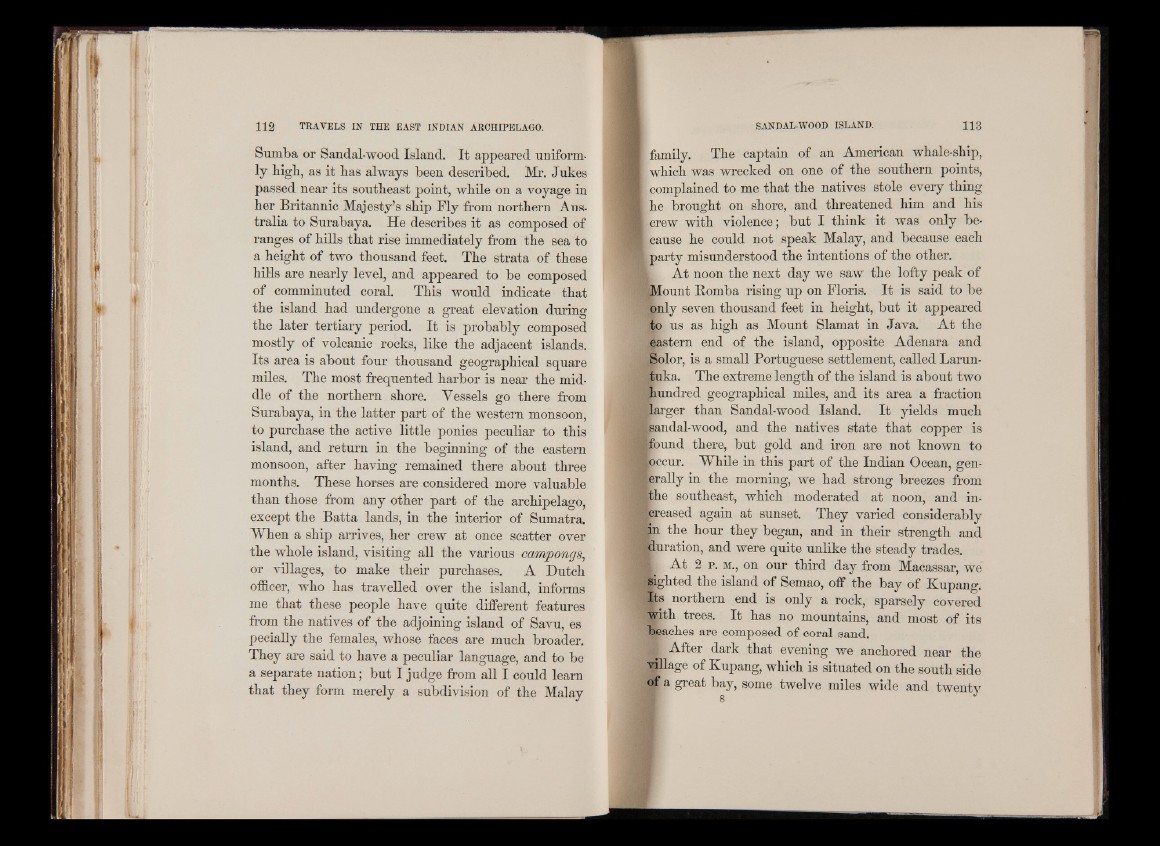
Sumba or Sandal-wood Island. It appeared uniformly
bigb, as it has always been described. Mr. Jukes
passed near its southeast point, while on a voyage in
her Britannic Majesty’s ship Fly from northern Australia
to Surabaya. He describes it as composed of
ranges of hills that rise immediately from the sea to
a height of two thousand feet. The strata of these
hills are nearly level, and appeared to be composed
of comminuted coraL This would indicate that
the island had undergone a great elevation during
the later tertiary period. It is probably composed
mostly of volcanic rocks, like the adjacent islands.
Its area is about four thousand geographical square
miles. The most frequented harbor is near the middle
of the northern shore. Vessels go there from
Surabaya, in the latter part of the western monsoon,
to purchase the active little ponies peculiar to this
island, and return in the beginning of the eastern
monsoon, after having remained there about three
months. These horses are considered more valuable
than those from any other part of the archipelago,
except the Batta lands, in the interior of Sumatra.
When a ship arrives, her crew at once scatter over
the whole island, visiting all the various ca/m/pongs,
or villages, to make their purchases. A Dutch
officer, who has travelled over the island, informs
me that these people have quite different features
from the natives of the adjoining island of Savu, es
pecially the females, whose faces are much broader.
They are said to have a peculiar language, and to be
a separate nation; but I judge from all I could learn
that they form merely a subdivision of the Malay
family. The captain of an American whale-ship,
which was wrecked on one of the southern points,
¡complained to me that the natives stole every thing
he brought on shore, and threatened him and his
j-crew with violence; but I think it was only be-
| cause he could not speak Malay, and because each
party misunderstood the intentions of the other.
At noon the next day we saw the lofty peak of
¡Mount Bomba rising up on Floris. I t is said to be
only seven thousand feet in height, but it appeared
to us as high as Mount Slamat in Java. At the
eastern end of the island, opposite Adenara and
Solor, is a small Portuguese settlement, called Larun-
tuka. The extreme length of the island is about two
hundred geographical miles, and its area a fraction
larger than Sandal-wood Island. I t yields much
|sandal-wood, and the natives state that copper is
pound there, but gold and iron are not known to
liccur. While in this part of the Indian Ocean, generally
in the morning, we had strong breezes from
Ithe southeast, which moderated at noon, and increased
again at sunset. They varied considerably
in the hour they began, and in their strength and
duration, and were quite unlike the steady trades.
At 2 p. m., on our third day from Macassar, we
|ighted the island of Semao, off the bay of Kupang.
Its northern end is only a rock, sparsely covered
with trees. It has no mountains, and most of its
beaches are composed of coral sand.
1 After dark that evening we anchored near the
Jp a g e of Kupang, which is situated on the south side
a great bay, some twelve miles wide and twenty